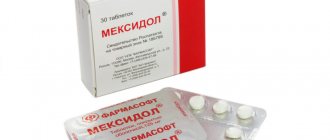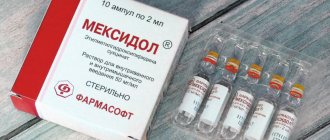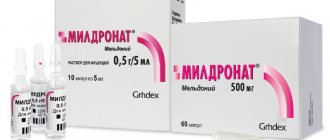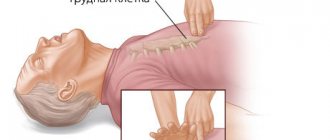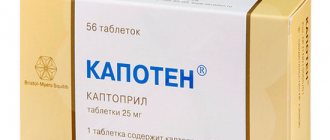Category: »» Diseases requiring complex treatment
Dubovskaya Nadezhda Alexandrovna
Chief physician of the Clinic, neurologist
Author of the article
Your palms become moist and your heart rate increases, but there seems to be no reason for such symptoms? Such signals are given by the brain when a panic attack “approaches”. For this pathology, psycho-emotional factors of occurrence are not necessary; it is enough for osteochondrosis to begin to progress in the cervical spine.
“Physiological” or “mental” depression: how to determine the cause of the disease
The first thing to remember is that panic attacks do not appear out of the blue; there is always a reason for their “awakening”. If a person does not have an innate predisposition to a depressive state, there have been no significant events in life that “knocked him out of the rut”, in 90% of cases we are talking about problems with the physical state of vital systems - cardiovascular and circulatory. The cause of uncontrollable panic and reluctance to enjoy life in the case of osteochondrosis is degeneration of vertebral cartilage in one form or another, which leads to disruption of the functioning of surrounding nerve roots and blood vessels. The resulting protrusions, hernias or other damage to the intervertebral disc lead to compression of the vessels providing blood supply to the brain. In 60% of cases, “advanced” osteochondrosis leads to oxygen starvation of the brain. Trying to normalize its condition, the “main organ” gives alarming signals, including those of a psychological nature.
Brief description of the drug
"Mexidol" refers to antioxidant agents used to improve blood supply and metabolic processes in the brain.
Release forms: injection solution and tablets for oral use. The development of the drug began in the 80s of the twentieth century. In 2003, its creators received a prize from the Government of the Russian Federation for synthesizing and introducing the drug into medical practice. The drug soon gained recognition among drugs in the field of neurology, surgery and narcology. It has a wide range of indications for use: from vegetative-vascular dystonia to ischemic cerebral circulatory disorders .
When is the product used?
The drug "Mexidol" is recommended for the treatment of ischemic circulatory disorders in the brain, vegetative-vascular and neurocirculatory dystonia, and cerebral dysfunction of atherosclerotic origin. The medicine is prescribed for various pathologies of the neurotic spectrum, neurosis-like personality changes, generalized anxiety disorders, to relieve intoxication with antipsychotic drugs, and for withdrawal symptoms.
This medication is also used in the treatment of acute inflammatory diseases of the peritoneum, pancreatic necrosis, peritonitis, conditions accompanied by tissue hypoxia, as well as pathologies such as epilepsy, Alzheimer's disease and parkinsonism.
How does the medicine affect the course of the disease?
The main difference in the pharmacodynamics of the drug from traditional neurotropic drugs is the lack of specific binding to receptors. "Mexidol" acts as an inhibitor of free radical processes, has protective properties against cell membranes, as well as antihypoxic, anticonvulsant and anxiolytic effects. The drug helps to increase the resistance of body systems in response to shock destabilization, increases resistance to ischemia, hypoxia, microcirculation disorders, and ethanol intoxication. The drug affects the activity of membrane-bound enzymes (adenylate cyclase, phosphodiesterase, acetylcholinesterase) and receptor complexes (benzodiazepine, GABA, acetylcholine), as a result of which their ability to bind to ligands increases. Mexidol preserves the structural and functional organization of cell membranes and improves the transmission of information in synaptic clefts.
In addition, the drug increases the amount of dopamine in the medulla, which in turn leads to activation of glycolysis and slowdown of redox reactions in the tricarbonic acid cycle. As a result, the level of creatine phosphate and ATP in mitochondria increases.
The medicine exhibits an anti-stress effect, which is realized in the normalization of behavior, improvement of sleep cycles, helps restore memory and learning processes, and reduces degenerative changes in brain structures.
When taking Mexidol and sedatives, neuroleptics, antidepressants, hypnotics, and anticonvulsants simultaneously, the effect of both drugs increases, which requires adjustment of the doses of the latter in order to reduce side effects.
Mexidol also has an analgesic effect. This effect is achieved due to a decrease in the sensitivity threshold. The medicine has anti-inflammatory properties, which are aimed at protecting the cellular structures of the body (including the brain) from the harmful effects of toxins and other harmful substances.
Features of use for vegetative-vascular dystonia
The medication should not be prescribed to patients with hypersensitivity to the active substance, acute kidney and liver diseases. It is not recommended to take the medicine for pregnant and nursing mothers. Also, you should not use the drug if you are allergic to vitamin B6.
As can be seen from the above, Mexidol is low-toxic and does not have many side effects, which means that the drug is safe for almost all groups of patients.
How to determine that the pathology is caused by osteochondrosis
The following symptoms are typical for panic attacks and depression:
• spontaneity. Anxiety may appear for no apparent reason;
• changes in character: increased aggressiveness or “tearfulness” in a balanced patient, apathy in an active patient, reluctance in sexual intimacy in a loving one;
• feeling of lack of air. Thus, the brain sends a signal about a lack of oxygen to the respiratory organs.
• sleep and appetite disturbances. Anxiety symptoms affect the nervous system. The desire to eat normally disappears, night rest becomes restless, and dreams become chaotic, often nightmarish.
If such symptoms are caused by osteochondrosis, then usually a person can also feel the following “bonuses”: dizziness, sudden changes in pressure (dystonia), headache, periodic numbness of the limbs and facial muscles, hearing and vision impairment.
If at least 2 of the above symptoms coincide, you will not be able to cope with depression and panic attacks on your own. A doctor's help is needed.
conclusions
VSD is a neurogenic multifactorial disease that adversely affects the quality of daily life. Patients complain of decreased ability to work, decreased alertness, and the appearance of chronic fatigue. Since there is no organic substrate for pathology, doctors use symptomatic remedies, as well as antioxidants and metabolic agents, which do not have an evidence base. A prominent representative of such drugs is Mexidol, a new generation drug widely used to treat patients with vegetative-vascular dystonia.
How can a specialist help with depression?
Depression, especially spontaneous depression, is not a reason to make an appointment with a psychiatrist. Start with something simple - a visit to a therapist. A thorough visual inspection will tell a good specialist a lot. The doctor’s goal is to make a correct diagnosis, on which 90% of the effectiveness of treatment depends. If there is a suspicion of osteochondrosis and the symptoms are associated specifically with this pathology, a laboratory study of blood biochemistry and ultrasound of the vessels of the cervical spine are recommended. After studying the results, it will be possible to decide what caused the panic attack and depression. Treatment is prescribed in accordance with the physical and psychological condition of the patient and is carried out comprehensively. The goal is to simultaneously normalize blood flow in narrowed vessels and relieve a person from emotional exhaustion. Therapeutic measures can be different: taking medications to improve brain function, physiotherapy, prescribing sedatives or antidepressants.
Categories
There are two types of classifications of PA (panic attacks). For reasons of occurrence:
- situational. The feeling of horror, as well as other symptoms, appear only in a certain situation, which has a negative impact on the person and his body as a whole;
- spontaneous. Can occur at any time, regardless of place, time or emotional state at the current moment;
- conditional-situational. It only appears when exposed to chemicals. For example, alcohol or tobacco.
By VSD type:
- hypotonic type. It is characterized by sweating, decreased blood pressure, shortness of breath, nausea and body weakness;
- hypertensive. In this type, the most common symptoms are rapid heartbeat, rapid pulse and increased blood pressure;
- mixed. The patient experiences two types of panic attacks at once during VSD.
Independent actions
In order not to “start” the disease and not get a chronic form of depression, preventive measures are necessary. Walking in the fresh air, physical exercise, giving up bad habits and even a simple change of pillow will help you regain the joy of life faster. As for the emotional state, it is better to be guided by your own interests. You can get rid of apathy by leading an active lifestyle - communicating with friends, going to the cinema, theater, and exhibitions. If a person is a homebody by nature and going outside is a feat for him, then first ensure that the rooms are well ventilated and have sufficient physical activity; this is easy to do at home. Remember, the sooner you start fighting the disease, the higher the effectiveness of treatment.
In this article we tried to answer your questions:
- How to recognize depression in osteochondrosis?
- How to treat depression with osteochondrosis?
- Can depression be treated with medication?
- Which doctor should I go to for depression?
Is it worth treating VSD with Mexidol and what are the patient reviews?
Vegetovascular dystonia is a widespread disease based on dysfunction and incoordination of the autonomic nervous system. Today there is no single correct way to treat it. They are treated taking into account the etiology of mental and emotional disorders, which includes many aspects. It is necessary to minimize the factors that provoke such a pathology and have a comprehensive influence on the mechanisms of the occurrence of the disease.
The versatility of Mexidol allows it to be successfully used in all clinical variants of VSD syndrome. The cardialgic type is characterized by pain in the heart, rapid pulse, and increased blood pressure (BP). The use of the drug allows you to get rid of such symptoms. In addition, it reduces mental and mental stress, stabilizes blood pressure. The tachycardial variant of the pathology is accompanied by a feeling of pulsation in the temples and an increase in heart rate. In such a case, the remedy will normalize the pulse, improve memory and attention.
In addition, the appointment of Mexidol for various forms of VSD allows you to get rid of the feeling of causeless fear and anxiety, signs of impaired cerebral circulation, Kandinsky-Clerambault syndrome and chronic fatigue.
For vegetative-vascular dystonia, the drug is prescribed in capsules of 125-250 mg three times a day, or intramuscularly (then the dosage is 0.05-0.1 g three times a day). If necessary, the dose can be changed. Treatment begins with taking two tablets per day, the amount of the drug is increased until the desired result is achieved. Six tablets is the maximum daily dose. The drug is withdrawn gradually.
Despite all the positive properties, the drug cannot be used independently, as this can sometimes lead to the development of adverse reactions and complications, as well as further deterioration of the patient’s condition.
"Mexidol" for vegetative-vascular dystonia, like other medications (for example, "Actovegin"), does not guarantee a reduction in symptoms, not to mention a cure. But the condition of patients taking this medication improves significantly, according to their reviews, namely: performance increases, well-being changes in a positive direction, and the influence of psycho-emotional stress on the patient’s behavior decreases. Sometimes people who use the medicine even experience a surge of strength and vitality.
Manifestations of obsessional neurosis
The most common manifestation of obsessional neurosis is fear, which is very difficult and sometimes almost impossible to overcome. Phobias make social contacts, work and all other aspects of life very difficult.
Another version of neurosis is, in fact, obsessive thoughts that a person cannot “drive” out of his head. These thoughts interfere with learning, concentration and greatly tire the patient. An important criterion: a person with obsessional neurosis never realizes his thoughts. The last type is compulsive. It manifests itself through obsessive movements and excessive ritualism.
Examples of obsessional neurosis
It is very easy to explain the essence of this phenomenon with examples. Let's say you believe that you shouldn't look in the mirror before leaving the house. However, if you accidentally look in the mirror, you will still leave the house without giving it much importance.
Or, for example, a black cat on the road will not force you to reschedule your business: you may be a little worried, but you will soon forget about it. A person with compulsive obsessions, looking in the mirror, will bolt the door and stay at home all day, and, having met a black cat, go to the pharmacy for sedatives.
As you can see, obsessional neurosis makes the patient’s life very difficult. This means that we can say confidently and definitely: this disease definitely needs treatment, and the treatment must be professional and complete.
